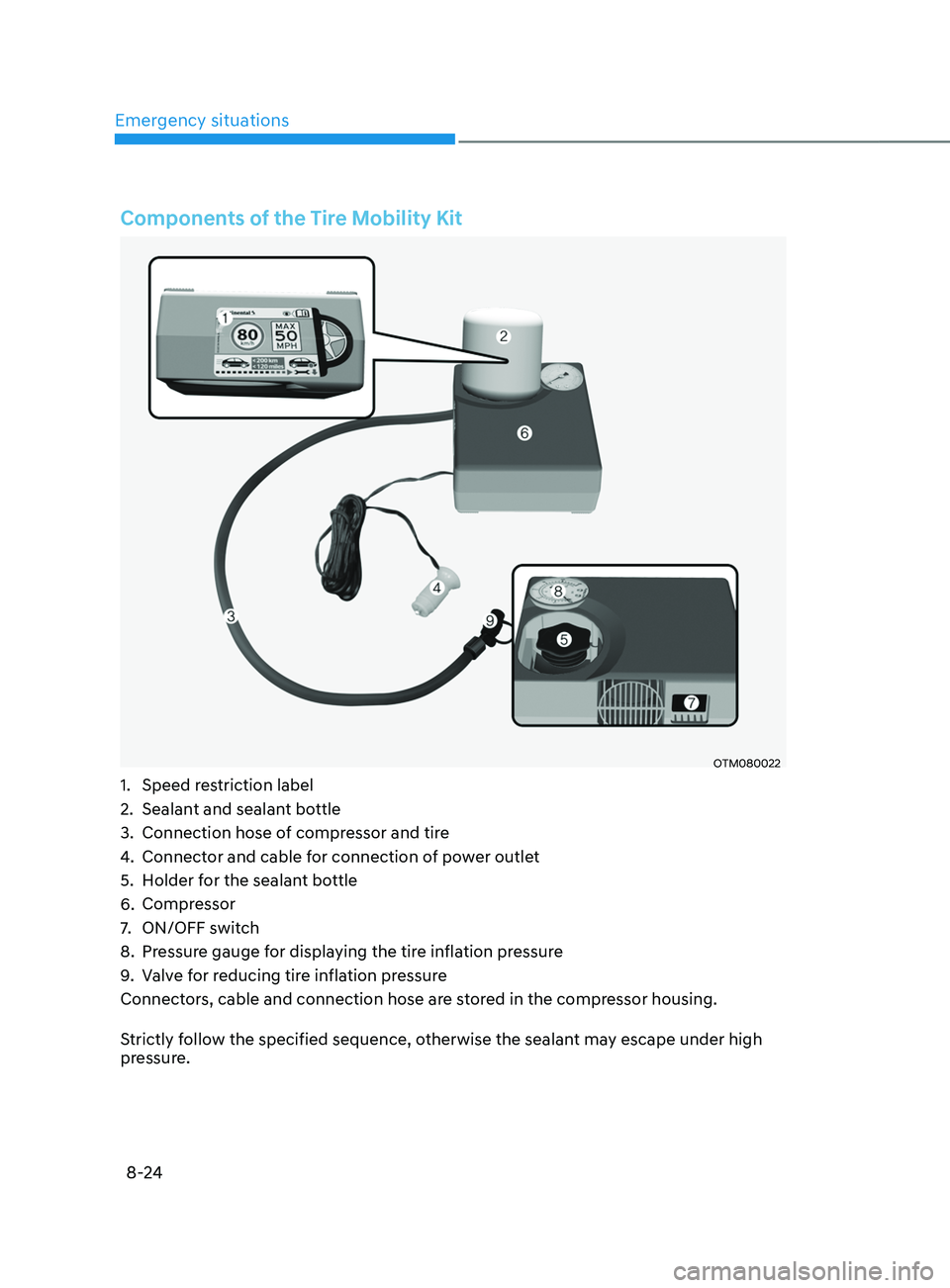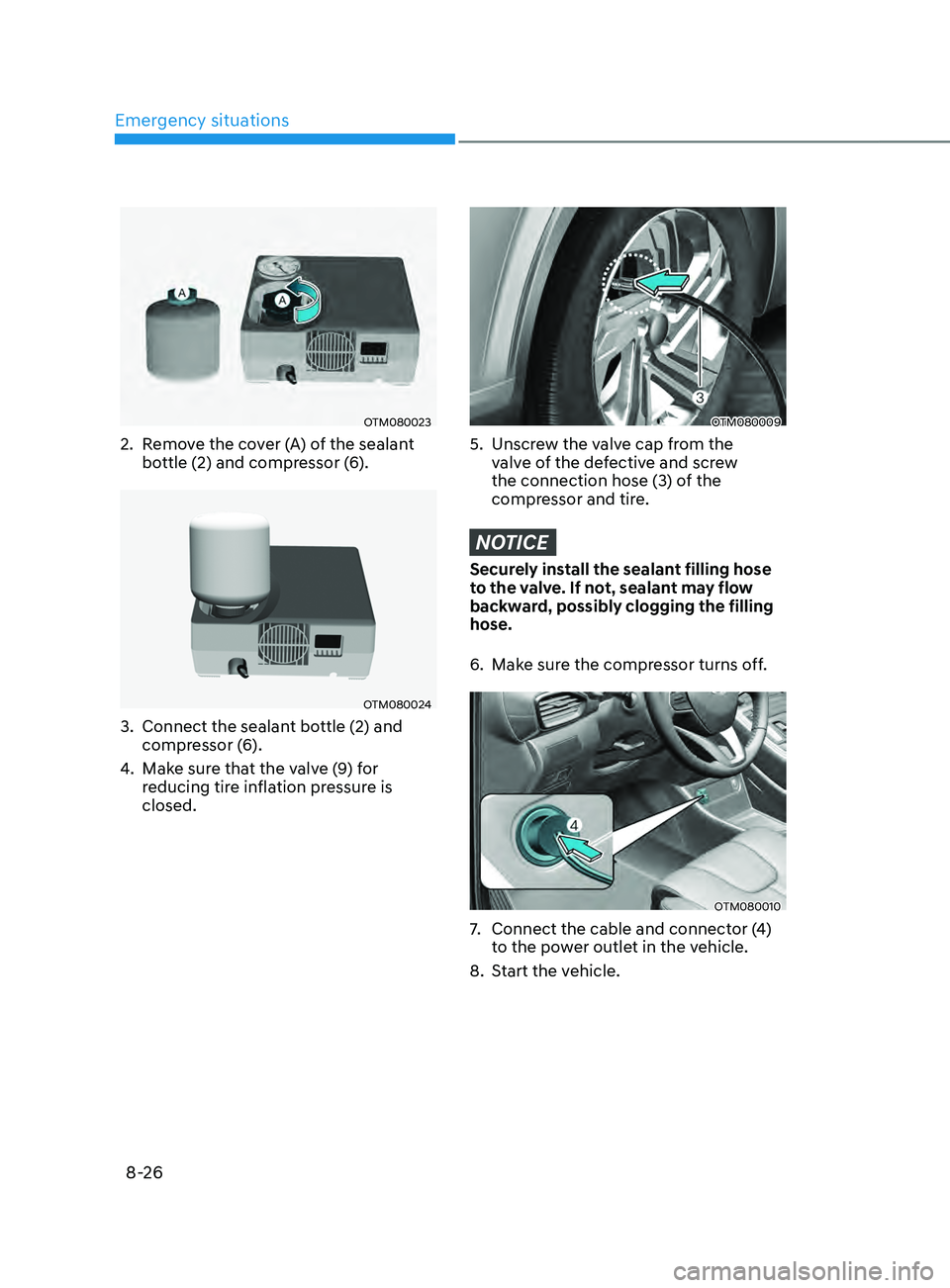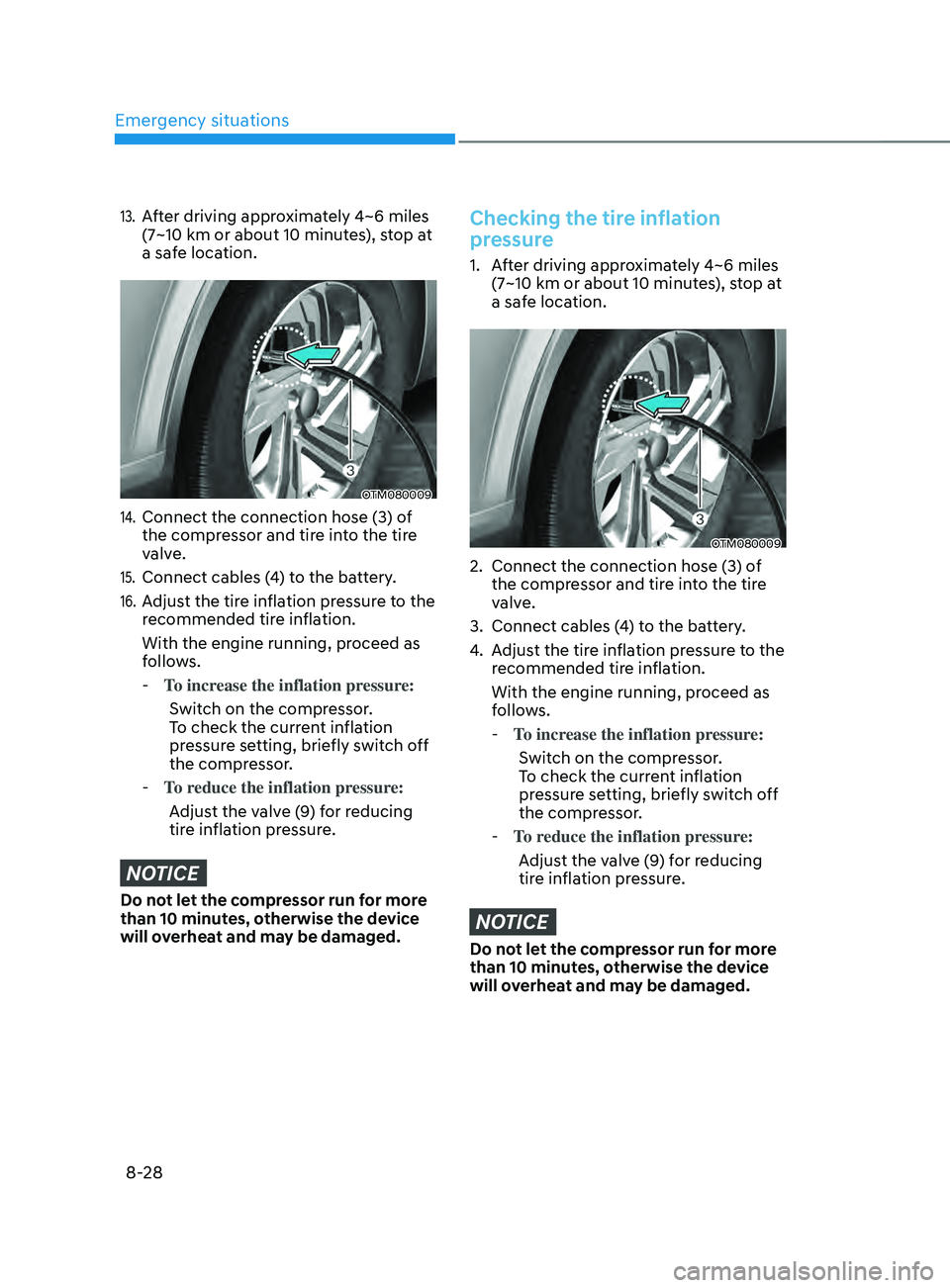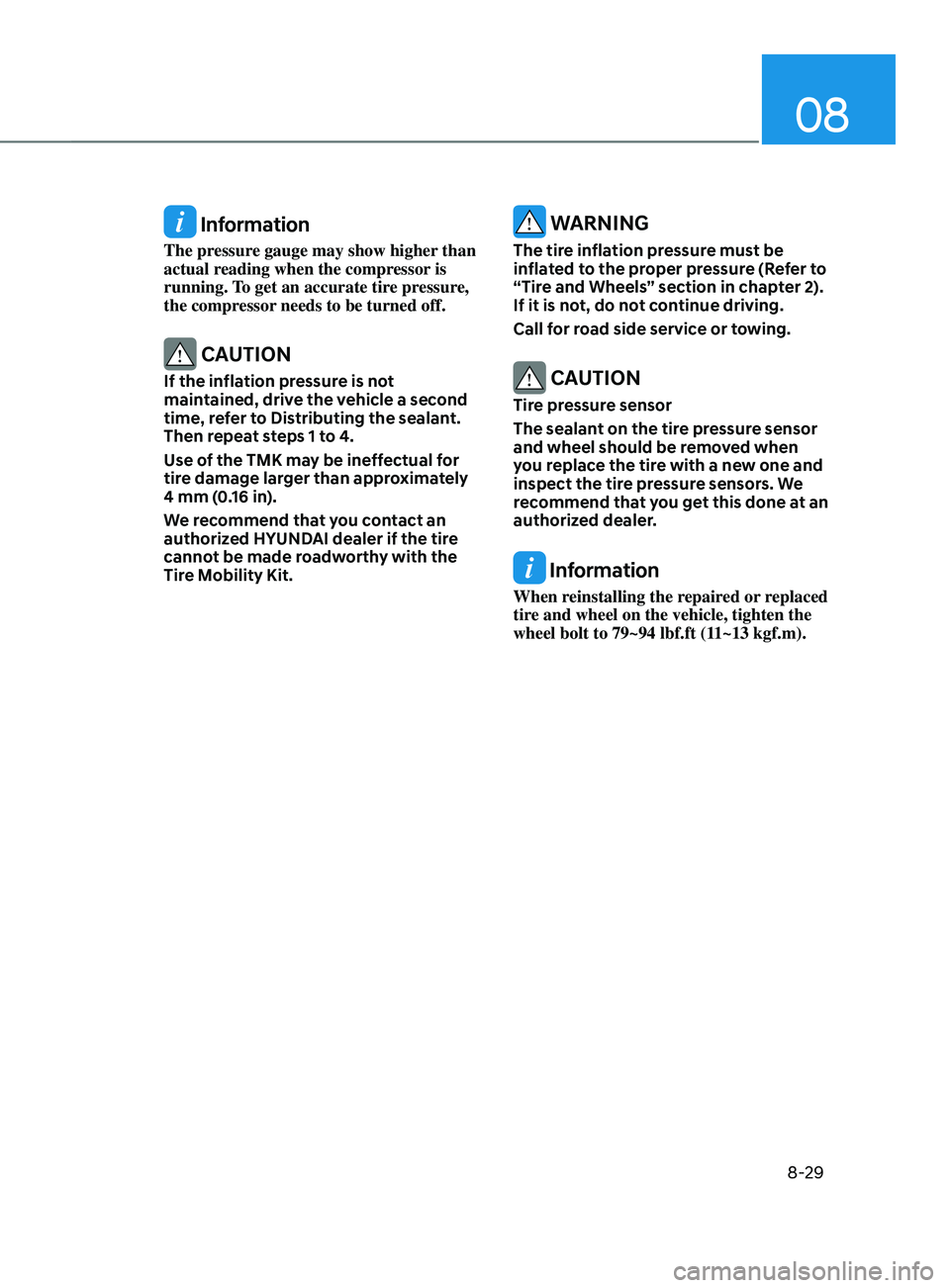2021 HYUNDAI SANTA FE LIMITED flat tire
[x] Cancel search: flat tirePage 542 of 636

Emergency situations
8-24
Components of the Tire Mobility Kit
OTM080022
1. Speed restriction label
2.
Sealant and sealan
t bottle
3.
Connection hose of compr
essor and tire
4.
Connector and cable f
or connection of power outlet
5.
Holder f
or the sealant bottle
6.
Compressor
7.
ON/OFF swit
ch
8.
Pressur
e gauge for displaying the tire inflation pressure
9.
Valv
e for reducing tire inflation pressure
Connectors, cable and connection hose are stored in the compressor housing.
Strictly follow the specified sequence, otherwise the sealant may escape under high
pressure.
Page 544 of 636

Emergency situations
8-26
OTM080023
2. Remove the cover (A) of the sealant
bottle (2) and compressor (6).
OTM080024
3. Connect the sealant bo ttle (2) and
compressor (6).
4.
Make sur
e that the valve (9) for
reducing tire inflation pressure is
closed.
OTM080009
5. Unscrew the valve cap from the
v alve of the defective and screw
the connection hose (3) of the
compressor and tire.
NOTICE
Securely install the sealant filling hose
to the valve. If not, sealant may flow
backward, possibly clogging the filling
hose.
6.
Make sur
e the compressor turns off.
OTM080010
7. Connect the cable and connector ( 4)
to the power outlet in the vehicle.
8.
Start the v
ehicle.
Page 545 of 636
![HYUNDAI SANTA FE LIMITED 2021 Owners Manual 08
8-27
9. With the engine running, switch
on the compressor by pressing [I]
and let it run for approximately 5~7
minutes to fill the sealant up to proper
pressure. (Refer to “Tire and Wheels” HYUNDAI SANTA FE LIMITED 2021 Owners Manual 08
8-27
9. With the engine running, switch
on the compressor by pressing [I]
and let it run for approximately 5~7
minutes to fill the sealant up to proper
pressure. (Refer to “Tire and Wheels”](/manual-img/35/56182/w960_56182-544.png)
08
8-27
9. With the engine running, switch
on the compressor by pressing [I]
and let it run for approximately 5~7
minutes to fill the sealant up to proper
pressure. (Refer to “Tire and Wheels”
section in chapter 2). The inflation
pressure of the tire after filling is
unimportant and will be checked/
corrected later.
Be careful not to overinflate the tire
and stay away from the tire when
filling it.
CAUTION
Do not attempt to drive your vehicle if
the tire pressure is below 200 kpa (29
psi). This could result in an accident due
to sudden tire failure.
10. Switch off the compressor.
11. Detach the hoses from the sealant
bottle connector and from the tire
valve.
Return the Tire Mobility Kit to its storage
location in the vehicle.
WARNING
Do not leave your vehicle running in
a poorly ventilated area for extended
periods of time. Carbon monoxide
poisoning and suffocation can occur.
Distributing the sealant
OOSH079022L
12. Immediately drive approximately 4~6
miles (7~10 km or about 10 minutes)
to evenly distribute the sealant in the
tire.
Do not exceed a speed of 50 mph (80
km/h). If possible, do not fall below a
speed of 12 mph (20 km/h).
While driving, if you experience any
unusual vibration, ride disturbance or
noise, reduce your speed and drive with
caution until you can safely pull off of the
side of the road.
Call for road side service or towing.
Page 546 of 636

Emergency situations
8-28
13. After driving approximately 4~6 miles
(7~10 km or about 10 minutes), stop at
a safe location.
OTM080009
14. Connect the connection hose (3) of
the compressor and tire into the tire
valve.
15. Connect cables (4) to the battery.
16. Adjust the tire inflation pressure to the
recommended tire inflation.
With the engine running, proceed as
follows.
-To incr
ease the inflation pressure:
Switch on the compressor.
To check the current inflation
pressure setting, briefly switch off
the compressor.
- To r
educe the inflation pressure:
Adjust the valve (9) for reducing
tire inflation pressure.
NOTICE
Do not let the compressor run for more
than 10 minutes, otherwise the device
will overheat and may be damaged.
Checking the tire inflation
pressure
1. After driving approximately 4~6 miles
(7~10 km or about 10 minut es), stop at
a safe location.
OTM080009
2. Connect the connection hose (3) o f
the compressor and tire into the tire
valve.
3.
Connect cables (4
) to the battery.
4.
Adjus
t the tire inflation pressure to the
recommended tire inflation.
With the engine running, proceed as
follows.
- To incr
ease the inflation pressure:
Switch on the compressor.
To check the current inflation
pressure setting, briefly switch off
the compressor.
- To r
educe the inflation pressure:
Adjust the valve (9) for reducing
tire inflation pressure.
NOTICE
Do not let the compressor run for more
than 10 minutes, otherwise the device
will overheat and may be damaged.
Page 547 of 636

08
8-29
Information
The pressure gauge may show higher than
actual reading when the compressor is
running. To get an accurate tire pressure,
the compressor needs to be turned off.
CAUTION
If the inflation pressure is not
maintained, drive the vehicle a second
time, refer to Distributing the sealant.
Then repeat steps 1 to 4.
Use of the TMK may be ineffectual for
tire damage larger than approximately
4 mm (0.16 in).
We recommend that you contact an
authorized HYUNDAI dealer if the tire
cannot be made roadworthy with the
Tire Mobility Kit.
WARNING
The tire inflation pressure must be
inflated to the proper pressure (Refer to
“Tire and Wheels” section in chapter 2).
If it is not, do not continue driving.
Call for road side service or towing.
CAUTION
Tire pressure sensor
The sealant on the tire pressure sensor
and wheel should be removed when
you replace the tire with a new one and
inspect the tire pressure sensors. We
recommend that you get this done at an
authorized dealer.
Information
When reinstalling the repaired or replaced
tire and wheel on the vehicle, tighten the
wheel bolt to 79~94 lbf.ft (11~13 kgf.m).
Page 550 of 636

Emergency situations
8-32
EmERgEnCY C OmmODITY (IF E QUIppED)
Your vehicle is equipped with emergency
commodities to help you respond to
emergency situation.
Fire extinguisher
If there is small fire and you know how
to use the fire extinguisher, follow these
steps carefully.
1.
Pull out the saf
ety pin at the top of the
extinguisher that keeps the handle
from being accidentally pressed.
2.
Aim the nozzle t
owards the base of
the fire.
3.
Stand appr
oximately 2.5 m (8 ft) away
from the fire and squeeze the handle
to discharge the extinguisher. If you
release the handle, the discharge will
stop.
4.
Sw
eep the nozzle back and forth
at the base of the fire. After the fire
appears to be out, watch carefully
since it may re-ignite.
First aid kit
Supplies for use in giving first aid such
as scissors, bandage and adhesive tape,
etc. are provided.
Triangle reflector
Place the triangle reflector on the road
to warn oncoming vehicles during
emergencies, such as when the vehicle is
parked by the roadside due to problems.
Tire pressure gauge (if equipped)
Tires normally lose some air in day-to-
day use, and you may have to add a air
periodically and usually it is not a sign of
a leaking tire, but of normal wear. Always
check tire pressure when the tires are
cold because tire pressure increases with
temperature.
To check the tire pressure, take the
following steps:
1.
Unscre
w the inflation valve cap that is
located on the rim of the tire.
2.
Press and hold the gauge agains
t the
tire valve. Some air will leak as you
begin and more will leak if you don’t
press the gauge in firmly.
3.
A firm non-leaking push will activa
te
the gauge.
4.
Read the tir
e pressure on the gauge
to see whether the tire pressure is low
or high.
5.
Adjus
t the tire pressure to the
specified pressure. Refer to “Tires and
Wheels” section in chapter 2.
6.
Reins
tall the inflation valve cap.
Page 552 of 636

Tires and wheels ........................................................................\
.....................9-32Tire care ........................................................................\
.............................................. 9-32
R ecommended cold tire inflation pressures ............................................................ 9-
32
Check tire inflation pressure
........................................................................\
............. 9-
33
Tire rotation
........................................................................\
........................................ 9-
34
Wheel alignment and tire balance
........................................................................\
.... 9-35
Tir
e replacement
........................................................................\
................................ 9-
35
Wheel replacement
........................................................................\
............................ 9-
36
Tire traction
........................................................................\
.....................................
...9-36
Tire maintenance
........................................................................\
............................... 9-
36
Tire sidewall labeling
........................................................................\
.......................... 9-
37
Low aspect ratio tires
........................................................................\
........................ 9-40
Fuses ........................................................................\
......................................... 9-41Instrument panel fuse replacement ........................................................................\
9-42
Engine compartmen t panel fuse replacement ....................................................... 9-43
F
use/relay panel description
........................................................................\
............ 9-44
Light bulbs ........................................................................\
................................ 9-51Headlamp, position lamp, turn signal lamp, Daytime Running Light (DRL)
replacement ........................................................................\
.....................................
..9-52
Side repeater lamp replacement
........................................................................\
..... 9-54
Rear combina
tion lamp replacement
...................................................................... 9-54
High moun
ted stop lamp replacement
.................................................................... 9-57
License pla
te lamp replacement
........................................................................\
...... 9-58
Int
erior light replacement
........................................................................\
................. 9-58
Appearance care ........................................................................\
..................... 9-60Exterior care ........................................................................\
...................................... 9-60
Int erior care ........................................................................\
....................................... 9-66
Emission control system........................................................................\
.........9-69
California perchlorate notice
........................................................................\
.. 9-72
Gasoline Particulate Filter (GPF) ........................................................................\
....... 9-72
9
Page 556 of 636

Maintenance
9-6
Owner maintenance schedule
When you stop for fuel:
• Check the engine oil level.
• Check the coolant level in the engine
coolant reservoir or the water-cooled
intercooler coolant reservoir.
• Check the windshield washer fluid
level.
• Check for low or under-inflated tires.
WARNING
Be careful when checking your coolant
level when the engine is hot. This may
result in coolant being blown out of the
opening and cause serious burns and
other injuries.
While operating your vehicle:
• Note any changes in the sound of the
exhaust or any smell of exhaust fumes
in the vehicle.
• Check for vibrations in the steering
wheel. Notice if there is any increased
steering effort or looseness in the
steering wheel, or change in its
straight-ahead position.
• Notice if your vehicle constantly turns
slightly or “pulls” to one side when
traveling on smooth, level road.
• When stopping, listen and check for
unusual sounds, pulling to one side,
increased brake pedal travel or “hard-
to-push” brake pedal.
• If any slipping or changes in the
operation of your transmission occurs,
check the transmission fluid level.
• Check the automatic transmission P
(Park) function.
• Check the parking brake.
• Check for fluid leaks under your
vehicle (water dripping from the air
conditioning system during or after
use is normal).
At least monthly:
• Check coolant level in the engine
coolant reservoir.
• Check the operation of all exterior
lights, including the stoplights, turn
signals and hazard warning flashers.
• Check the inflation pressures of all
tires including the spare for tires that
are worn, show uneven wear, or are
damaged.
• Check for loose wheel lug nuts.
At least twice a year: (i.e., every
Spring and Autumn)
• Check radiator, heater and air
conditioning hoses for leaks or
damage.
• Check windshield washer spray and
wiper operation. Clean wiper blades
with a clean cloth dampened with
washer fluid.
• Check headlamp alignment.
• Check muffler, exhaust pipes, shields
and clamps.
• Check the seat belts for wear and
function.
At least once a year:
• Clean body and door drain holes.
• Lubricate door hinges and hood
hinges.
• Lubricate door and hood locks and
latches.
• Lubricate door rubber weather strips.
• Check the air conditioning system.
• Inspect and lubricate automatic
transmission linkage and controls.
• Clean the battery and terminals.
• Check the brake fluid level.